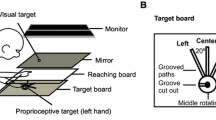Abstract
Perturbation-induced reach-to-grasp reactions are dependent on vision to capture environmental features of potential support surfaces. Previous research proposed the use of an intrinsic visuospatial map of the environment to reduce delays in motor responses (e.g., stepping, grasping a handrail). Forming such a map from foveal vision would be challenging during movement as it would require constant foveal scanning. The objective of this study was to determine if compensatory reach-to-grasp reactions could be successfully executed while relying on a visuospatial map acquired using peripheral vision. Subjects were instructed to respond to a perturbation by grasping a handle randomly located at 0°, 20° or 40° in their field of view under three visual conditions: full vision throughout the entire trial (FV), vision available prior to perturbation only (MAP), and vision available post-perturbation only (ONLINE). Electromyography was used to determine reaction time and kinematic data were collected to determine initial reach angle. Overall, participants were successful in arresting whole-body motion across all visual conditions and handle locations. Initial reach angles were target specific when vision was available prior to perturbation onset (FV and MAP). However, the 40° handle location produced a greater initial reach angle in MAP, suggesting some limitations for mapping in the further visual periphery. These findings suggest that peripheral vision contributes to the ability to spatially locate targets by building an a priori visuospatial map, which benefits the control of rapid compensatory reach-to-grasp reactions evoked in the response to unpredictable events of instability.



Similar content being viewed by others
References
Cheng KC, McKay SM, King EC, Maki BE (2012) Reaching to recover balance in unpredictable circumstances: is online visual control of the reach-to-grasp reaction necessary or sufficient? Exp Brain Res 218(4):589–599. https://doi.org/10.1007/s00221-012-3051-6
Colby CL, Duhamel J, Goldberg ME (1995) Oculocentric spatial representation in parietal cortex. Cereb Cortex 5:470–481. https://doi.org/10.1093/cercor/5.5.470
Duhamel JR, Colby CL, Goldberg ME (1992) The updating of the representation of visual space in parietal cortex by intended eye movements. Science 255:90–92. https://doi.org/10.1126/science.1171599
Gage WH, Zabjeck KF, Hill SW, McIlroy WE (2007) Parallels in control of voluntary and perturbation-evoked reach-to-grasp movements: EMG and kinematics. Exp Brain Res 181:627–637. https://doi.org/10.1007/s00221-007-0959-3
Ghafouri M, McIlroy WE, Maki BE (2004) Initiation of rapid reach-and-grasp balance reactions: is a pre-formed visuospatial map used in controlling the initial arm trajectory? Exp Brain Res 155:532–536. https://doi.org/10.1007/s00221-004-1855-8
González-Alvarez C, Subramanian A, Pardhan S (2007) Reaching and grasping with restricted peripheral vision. Ophthalmic Physiol Opt 27:265–274. https://doi.org/10.1111/j.1475-1313.2007.00476.x
King E, McKay S, Cheng K, Maki B (2010) The use of peripheral vision to guide perturbation-evoked reach-to-grasp balance-recovery reactions. Exp Brain Res 207:105–118. https://doi.org/10.1007/s00221-010-2434-9
King EC, Lee TA, McKay SM, Scovil CY, Peters AL, Pratt J, Maki BE (2011) Does the “eyes lead the hand” principle apply to reach-to-grasp movements evoked by unexpected balance perturbations? Hum Mov Sci 30:368–383. https://doi.org/10.1016/j.humov.2010.07.005
Maki BE, McIlroy WE (1997) The role of limb movements in maintaining upright stance: the “change-in-support” strategy. Phys Ther 77:488–507. https://doi.org/10.1093/ptj/77.5.488
Maki BE, McIlroy WE (2005) Change-in-support balance reactions in older persons: an emerging research area of clinical importance. Neurol Clin 23:751–783. https://doi.org/10.1016/j.ncl.2005.01.002
Maki BE, McIlroy WE (2006) Control of rapid limb movements for balance recovery: Age-related changes and implications for fall prevention. Age Ageing 35:ii12–ii18. https://doi.org/10.1093/ageing/afl078
Maki BE, McIlroy WE, Fernie GR (2003) Change-in-support reactions for balance recovery. IEEE Eng Med Biol Mag 22(2):20–26. https://doi.org/10.1109/MEMB.2003.1195691
McIlroy WE, Maki BE (1995) Early activation of arm muscles follows external perturbation of upright stance. Neurosci Lett 184:177–180. https://doi.org/10.1016/0304-3940(94)11200-3
Miyasike-daSilva V, Allard F, McIlroy W (2011) Where do we look when we walk on stairs? Gaze behaviour on stairs, transitions, and handrail. Exp Brain Res 209:73–83. https://doi.org/10.1007/s00221-010-2520-z
Prado J, Clavagnier S, Otzenberger H, Scheiber C, Kennedy H, Perenin M (2005) Two cortical systems for reaching in central and peripheral vision. Neuron 48:849–858. https://doi.org/10.1016/j.neuron.2005.10.010
Ricker KL, Elliott D, Lyons J, Gauldie D, Chua R, Byblow W (1999) The utilization of visual information in the control of rapid sequential aiming movements. Acta Psychol 103:103–123. https://doi.org/10.1016/S0001-6918(99)00026-8
Scovil CY, Zettel JL, Maki BE (2008) Stepping to recover balance in complex environments: is online visual control of the foot motion necessary or sufficient? Neurosci Lett 445:108–112. https://doi.org/10.1016/j.neulet.2008.08.062
Wurtz RH (2008) Neuronal mechanisms of visual stability. Vis Res 48:2070–2089. https://doi.org/10.1016/j.visres.2008.03.021
Acknowledgements
This work was supported by the Natural Sciences and Engineering Research Council of Canada (WEM). The authors thank Matt Snyder and Jeff Rice for technical assistance.
Funding
NSERC.
Author information
Authors and Affiliations
Corresponding author
Ethics declarations
Conflict of interest
The authors state that they have no conflict of interest.
Additional information
Communicated by Francesco Lacquaniti.
Publisher's Note
Springer Nature remains neutral with regard to jurisdictional claims in published maps and institutional affiliations.
Rights and permissions
Springer Nature or its licensor holds exclusive rights to this article under a publishing agreement with the author(s) or other rightsholder(s); author self-archiving of the accepted manuscript version of this article is solely governed by the terms of such publishing agreement and applicable law.
About this article
Cite this article
Williams, L., Miyasike-daSilva, V., Staines, W.R. et al. Can we use peripheral vision to create a visuospatial map for compensatory reach-to-grasp reactions?. Exp Brain Res 240, 2739–2746 (2022). https://doi.org/10.1007/s00221-022-06452-1
Received:
Accepted:
Published:
Issue Date:
DOI: https://doi.org/10.1007/s00221-022-06452-1




